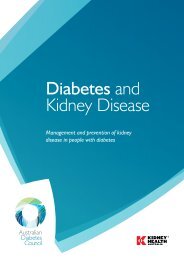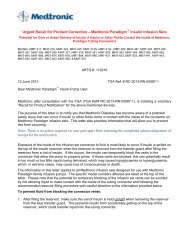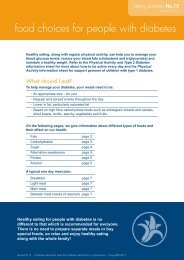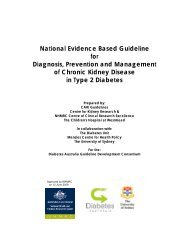Part 6: Detection and Prevention of Foot Problems in Type 2 Diabetes
Part 6: Detection and Prevention of Foot Problems in Type 2 Diabetes
Part 6: Detection and Prevention of Foot Problems in Type 2 Diabetes
Create successful ePaper yourself
Turn your PDF publications into a flip-book with our unique Google optimized e-Paper software.
Background - Cl<strong>in</strong>ical <strong>Detection</strong> <strong>of</strong> Peripheral Vascular DiseasePeripheral vascular disease (PVD) is common <strong>in</strong> people with <strong>Type</strong> 2 diabetes be<strong>in</strong>gpresent <strong>in</strong> 8% at the time <strong>of</strong> diagnosis <strong>and</strong> <strong>in</strong> 45% <strong>of</strong> people who have had diabetes for20 years (Hiatt & Sussman, 1994). The prevalence <strong>of</strong> PVD at diagnosis <strong>of</strong> diabetes<strong>and</strong> the risk <strong>of</strong> develop<strong>in</strong>g PVD over time <strong>in</strong>crease with <strong>in</strong>creas<strong>in</strong>g age (Davis et al,1997). As reviewed <strong>in</strong> Section 2, PVD is an important risk factor for amputation.Although various factors predict the outcome <strong>of</strong> foot ulcers <strong>in</strong> people with diabetes,the severity <strong>of</strong> exist<strong>in</strong>g lower extremity arterial disease is considered to be the ma<strong>in</strong><strong>in</strong>dependent risk factor for major amputation (Pecoraro et al, 1990).While sophisticated <strong>and</strong> <strong>in</strong>vasive tests are now available to quantify the extent <strong>of</strong> PVD<strong>in</strong> people with diabetes, cl<strong>in</strong>ical means <strong>of</strong> identify<strong>in</strong>g those with PVD rema<strong>in</strong>important <strong>in</strong> the primary care sett<strong>in</strong>g. A history <strong>of</strong> <strong>in</strong>termittent claudication is a wellrecognised feature <strong>of</strong> PVD. Claudication pa<strong>in</strong> arises <strong>in</strong> an exercis<strong>in</strong>g muscle when theperfusion pressure <strong>of</strong> the blood dur<strong>in</strong>g exercise is <strong>in</strong>sufficient to remove anaerobicmetabolites <strong>and</strong> ma<strong>in</strong>ta<strong>in</strong> muscle function. In contrast to those without diabetes, thearteries below the knee are more severely affected <strong>in</strong> people with diabetes (LoGerfo &C<strong>of</strong>fman, 1984). Exercise-<strong>in</strong>duced leg pa<strong>in</strong> most commonly beg<strong>in</strong>s <strong>in</strong> the calf but canextend to the thigh or buttocks if exercise is cont<strong>in</strong>ued. Severe claudication is most<strong>of</strong>ten the result <strong>of</strong> multilevel arterial disease.Palpation <strong>of</strong> foot pulses is a rout<strong>in</strong>e part <strong>of</strong> the assessment <strong>of</strong> the peripheral circulation<strong>in</strong> people with diabetes. Pedal pulse palpation is a simple <strong>and</strong> adequately reliablecl<strong>in</strong>ical method (Meade et al, 1968). Other cl<strong>in</strong>ical signs which may be useful <strong>in</strong>cludeatrophic sk<strong>in</strong> <strong>and</strong> loss <strong>of</strong> hair, pallor on elevation followed by dusky colour ondependency <strong>and</strong> a prolonged capillary fill<strong>in</strong>g time.Several studies have reported that cl<strong>in</strong>ical signs <strong>of</strong> PVD correlate well with future risk<strong>of</strong> amputation although it should be remembered that the absence <strong>of</strong> claudication doesnot exclude a diagnosis <strong>of</strong> PVD s<strong>in</strong>ce pa<strong>in</strong> may not be a feature if peripheralneuropathy is also present. Also some <strong>of</strong> the controversy about the usefulness <strong>of</strong>rout<strong>in</strong>e cl<strong>in</strong>ical exam<strong>in</strong>ation <strong>of</strong> peripheral pulses is <strong>in</strong> part related to <strong>in</strong>ter-observervariation <strong>and</strong> a relatively high false-positive rate for the presence <strong>of</strong> PVD.Evidence - Cl<strong>in</strong>ical <strong>Detection</strong> <strong>of</strong> Peripheral Vascular DiseaseIntermittent claudication is <strong>in</strong>dicative <strong>of</strong> peripheral vascular diseaseA cross-sectional study <strong>in</strong> 631 predom<strong>in</strong>antly male veterans (mean age 63.4 years)with diabetes <strong>in</strong> a general medical cl<strong>in</strong>ic compared the accuracy <strong>of</strong> data from history<strong>and</strong> physical exam<strong>in</strong>ation on the detection <strong>of</strong> severe PVD, assessed by an ankle-arm<strong>in</strong>dex (AAI) ≤0.5 us<strong>in</strong>g Doppler blood pressure measurements (Boyko et al, 1997).The study showed that 46 people had severe PVD (AAI ≤0.5) <strong>in</strong> the right leg, 44 <strong>in</strong>the left leg, <strong>and</strong> 26 <strong>in</strong> both legs. Claudication symptoms had a sensitivity <strong>of</strong> 50% <strong>and</strong>a specificity <strong>of</strong> 87% for PVD by AAI, compared with 65% <strong>and</strong> 78% for absent ordim<strong>in</strong>ished peripheral pulses <strong>and</strong> 22% <strong>and</strong> 93% for venous fill<strong>in</strong>g time >20 seconds.A stepwise logistic regression model identified age, symptom <strong>of</strong> claudication, selfreportedhistory <strong>of</strong> PVD, absent or dim<strong>in</strong>ished peripheral pulses <strong>and</strong> prolonged48
















